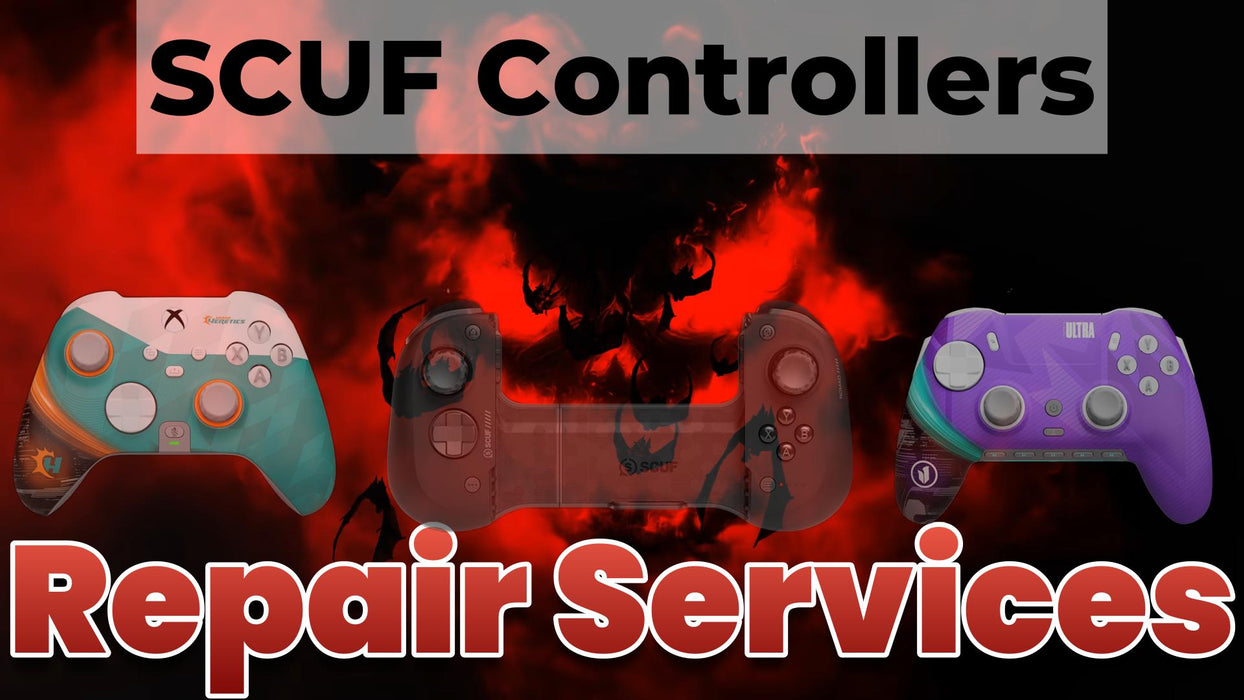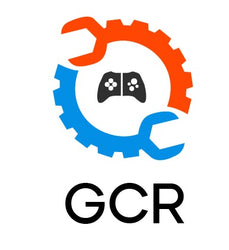

All SCUF Gaming Controller Repairs
Get a FREE Quote
SCUF Gaming Controllers are popular for their customizability, premium features and performance enhancements, but like all hardware, they are prone to certain common issues.
Here are the most common problems associated with SCUF Gaming Controllers repairs:
1. Stick Drift
- Problem: The analog sticks may register movement even when they are in a neutral position, causing unwanted actions in games.
- Cause: Worn-out potentiometers, dust buildup inside the controller, or wear on the joystick mechanism.
-
Solution:
- Cleaning: Open the controller and clean around the joystick area.
- Potentiometer Replacement: If the stick is worn out, replacing the potentiometer or entire joystick module may be necessary.
- Recalibration: Recalibrate the controller to fix minor drift issues.
2. Unresponsive Paddles
- Problem: The rear paddles on SCUF controllers stop responding or do not register inputs.
- Cause: Damaged paddle switches, poor connection, or worn-out wiring inside the controller.
-
Solution:
- Switch Repair: Open the controller and inspect the paddle switches. Replace them if necessary.
- Wiring Repair: Check for loose connections or faulty wiring that may be causing the issue.
3. Sticky or Unresponsive Buttons
- Problem: The face buttons (X, O, Square, Triangle) or the D-pad become sticky or unresponsive during gameplay.
- Cause: Dirt, dust, or debris buildup under the buttons, or worn-out rubber membranes.
-
Solution:
- Cleaning: Disassemble the controller and clean the buttons and the area underneath them.
- Membrane Replacement: Replace the rubber membrane that sits under the buttons if it’s worn out.
4. Trigger Stops Not Working
- Problem: The adjustable trigger stops on SCUF controllers may stop functioning correctly or not activate as intended.
- Cause: Wear and tear on the trigger mechanism, faulty trigger stop mechanism, or misalignment.
-
Solution:
- Adjustment: Readjust the trigger stops manually.
- Trigger Replacement: If the trigger mechanism is damaged, it may need to be replaced or repaired.
5. Disconnected or Loose Thumbsticks
- Problem: The thumbsticks feel loose or disconnect from the controller base during use.
- Cause: Wear on the thumbstick assembly, or internal damage.
-
Solution:
- Thumbstick Replacement: Replace the loose or damaged thumbsticks with new ones.
- Tighten Assembly: Ensure the thumbstick module is securely fastened to the controller.
6. Battery Issues (SCUF Vantage Wireless Controllers)
- Problem: Wireless SCUF controllers may not hold a charge, or they might not charge at all.
- Cause: Faulty battery, damaged charging port, or software issues.
-
Solution:
- Battery Replacement: Replace the internal battery if it’s no longer holding a charge.
- Charging Port Repair: Inspect the charging port for damage and repair it if needed.
- Firmware Update: Perform a firmware update to fix software-related charging issues.
7. Controller Disconnecting During Gameplay
- Problem: The controller may disconnect from the console or PC randomly during use.
- Cause: Faulty USB cable, damaged wireless receiver, or internal connectivity issues.
-
Solution:
- Cable Replacement: Try using a different USB cable if the controller is wired.
- Receiver Repair: Check the wireless receiver and replace it if it’s faulty.
- Wiring Check: Inspect the internal wiring for any loose connections or damage.
8. Vibration Not Working
- Problem: The controller’s vibration function (rumble) is not working during gameplay.
- Cause: Faulty or disconnected vibration motors, or internal wiring issues.
-
Solution:
- Motor Replacement: Replace the rumble motors if they are damaged or not functioning properly.
- Wiring Repair: Check the wiring that connects to the vibration motors and repair any loose or damaged connections.
9. Worn-Out Rubber Grips
- Problem: The rubber grips on the back or sides of the controller may peel off or wear down over time.
- Cause: Extended use, poor adhesive quality, or wear from hand moisture.
-
Solution:
- Grip Replacement: Replace the worn-out grips with new ones. SCUF offers replacement grips for most models.
10. Loose or Damaged Triggers
- Problem: The L2 and R2 triggers feel loose, or they do not register inputs correctly.
- Cause: Worn-out trigger springs, internal mechanism damage, or debris blocking the trigger.
-
Solution:
- Trigger Repair: Open the controller and inspect the trigger mechanism for damage. Replace or tighten any loose parts.
- Spring Replacement: Replace any broken or worn-out springs in the trigger mechanism.
11. Controller Not Syncing with Console
- Problem: The controller fails to sync with the console (PS4, PS5, or Xbox).
- Cause: Firmware issues, damaged USB ports, or internal connectivity problems.
-
Solution:
- Hard Reset: Perform a hard reset of the controller to clear any sync issues.
- Firmware Update: Update the controller’s firmware to resolve connectivity problems.
- USB Port Repair: If the USB port is damaged, repair or replace it.
12. Remapping Issues
- Problem: The custom button remapping feature does not work, or the controller does not remember remapped settings.
- Cause: Software or firmware bugs, or faulty remapping chip.
-
Solution:
- Firmware Update: Update the controller's firmware to fix remapping bugs.
- Chip Replacement: If the remapping chip is faulty, it may need to be replaced.
13. Sticky or Jammed Paddles
- Problem: The rear paddles may become sticky or jammed, making them difficult to press.
- Cause: Dirt buildup, or the paddles are worn out or misaligned.
-
Solution:
- Cleaning: Disassemble the controller and clean the paddles and their housing.
- Realignment: Ensure the paddles are properly aligned to prevent jamming.
- Paddle Replacement: If the paddles are worn or damaged, replace them.
14. Broken or Damaged Faceplate
- Problem: The faceplate may crack, break, or become loose due to impact or overuse.
- Cause: Physical damage from dropping the controller or extended use.
-
Solution:
- Faceplate Replacement: Replace the broken faceplate with a new one. SCUF offers customizable faceplates that can be swapped easily.
15. Headphone Jack Not Working
- Problem: The headphone jack on the controller does not transmit audio or register a headset.
- Cause: Damaged audio port, faulty internal wiring, or software issues.
-
Solution:
- Port Repair: Inspect the headphone jack and repair or replace it if damaged.
- Wiring Check: Ensure the internal wiring connected to the jack is intact.
- Firmware Update: Update the controller’s firmware to fix any software-related issues with the headphone jack.
16. Rapid Button Wear
- Problem: Buttons like X, O, Square, and Triangle wear down quickly due to frequent use.
- Cause: Poor material quality or extensive use during gameplay.
-
Solution:
- Button Replacement: Replace the worn-out buttons with new ones.
- Use High-Quality Parts: Ensure that the replacement buttons are of high quality to avoid quick wear.
Conclusion:
SCUF controllers, while offering premium features and customization, are prone to certain hardware issues due to extended use. Common problems include stick drift, unresponsive paddles, worn-out buttons, and loose triggers. Most issues can be resolved by cleaning, replacing worn parts, or recalibrating the controller. In some cases, repairs involving internal components like potentiometers, motors, or wiring are necessary to restore the controller's performance.
Product Reviews
Add customer reviews and testimonials to showcase your store's happy customers.
Author's name
Add customer reviews and testimonials to showcase your store's happy customers.
Author's name
Add customer reviews and testimonials to showcase your store's happy customers.
Author's name
